The Next Battleground in the Fight to Close the Rikers Island Jails
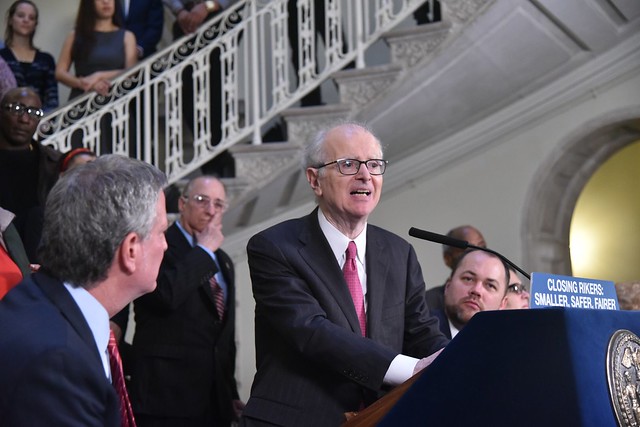
Jonathan Lippman, one of the authors (photo: John McCarten/NYC Council)
The New York State Legislature recently passed a landmark suite of criminal justice reforms that will profoundly re-shape the justice system in New York. Among other things, the reforms should help recalibrate the balance of power between prosecutors and defense attorneys and accelerate the effort to close the notorious jail complex on Rikers Island.
A recent analysis found that by reducing the use of bail, the legislative reforms would result in the release of more than 40% of the defendants held in pretrial detention in New York City.
Legislative changes like these almost always generate significant public attention -- newspaper headlines, social media traffic, and the like. But if we hope to create a justice system that truly serves as an international model of fairness and effectiveness, we cannot rely solely, or even primarily, on legislation.
The kind of cultural change that is required in New York cannot simply be imposed from on high by political actors; it must be embraced by frontline practitioners – judges, attorneys, police officers, and others. These officials must be given the tools they need to both maintain public safety and ensure that every defendant and every victim is treated with dignity and respect.
This means making long-term investments in training and education – for example, teaching justice officials about the long-lasting effects of trauma among the justice-involved population. It means reshaping the physical plant of the justice system so that our police precincts and courthouses and jails are designed to welcome rather than intimidate users. And it means focusing in the trenches on boring and technical issues like the speed with which cases are processed by the justice system.
Take felony cases. New York’s court system has long expected felonies to be resolved within 180 days of an indictment. Yet, among indicted felonies resolved in 2018 in New York City, despite the herculean efforts of court administrators, cases averaged more than ten months to a resolution. Shortening this timeframe doesn't make sense just from an efficiency standpoint -- it should also help reduce the jail population in New York City, since many of these defendants are currently detained on Rikers Island while their cases are pending.
The new legislative reform should make a real difference -- most discovery becomes automatic and must be completed within 15 days of arraignment. Chief Judge Janet DiFiore has also made inroads in recent months, employing new technology, changing judicial assignments, and using her bully pulpit to make improved timeliness the top judicial priority.
And, yet, there is still enormous potential for delay within the courts. What else can be done?
Judges and attorneys can take several practical steps to make the constitutional right to a speedy trial more of an everyday reality.
For one, the parties can shrink the number of days in between each court appearance. In 2016, the Office of Court Administration endorsed a 30-day cap. As adjournment length declines, there will be less idle time waiting for the next court date.
Second, once discovery is complete, judges can make it a routine practice to convene attorneys in a case conference outside the courtroom. A conference is an opportunity to have an honest discussion about the strengths and weaknesses in each side’s case and, potentially, to reach a good faith plea agreement sooner rather than later in case proceedings.
Third, judges and attorneys can agree to formal guidelines up front that state exactly what each party is responsible for accomplishing in between each court appearance -- in lieu of constantly reassessing progress at each successive court date.
Earlier this year, the Brooklyn Supreme Court, with the cooperation of the Brooklyn District Attorney and the local defense bar, launched an experiment that seeks to move in these directions. With support from the Art for Justice Fund and the Center for Court Innovation, the parties agreed to use a case processing roadmap that clearly defines what should happen from one court appearance to the next in indicted felony cases.
The Brooklyn pilot is an attempt to implement case processing reforms recommended by both the Mayor’s Office of Criminal Justice and the Independent Commission on New York City Criminal Justice and Incarceration Reform. If successful, it can potentially serve as a model for the rest of the city.
To close the Rikers Island jails and create a better justice system is a complicated endeavor that will require sustained effort over the course of many years. Policy, at both the city and state level, has an important role to play. But so does practice.
There aren’t going to be any ticker-tape parades when felony cases are resolved four months quicker, but it is precisely these kinds of changes that are the critical next frontier in the fight for criminal justice reform in New York.
***
Jonathan Lippman is a former chief judge of New York State, of counsel at Latham & Watkins LLP, and chair of the Independent Commission on New York City Criminal Justice and Incarceration Reform. Greg Berman is Director of Center for Court Innovation.
***
Have an op-ed idea or submission for Gotham Gazette? Email This email address is being protected from spambots. You need JavaScript enabled to view it.
As Public School Parent Leaders, We Say Don’t Raise the Charter Cap
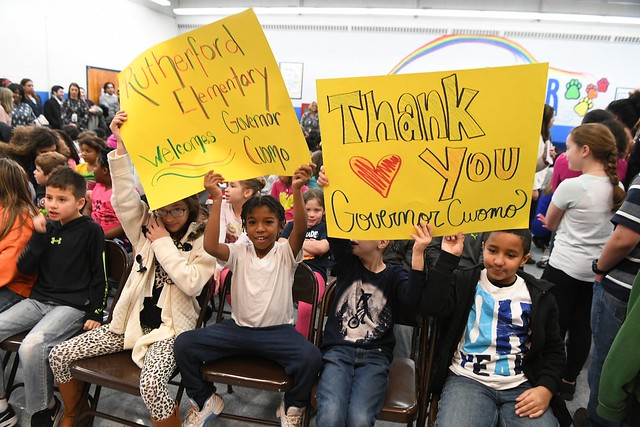
(photo: Governor's Office)
There has been much discussion that the state Legislature and Governor Cuomo may raise the cap on charter schools, especially since the sub-cap of 235 charter schools in New York City has now been reached. As public school parents and co-chairs of the Education Council Consortium, which represents the elected parent leaders of Community Education Councils across the five boroughs, we overwhelmingly oppose raising the cap because this would have a seriously detrimental impact on our public schools.
Privately-run charter schools in New York City are already costing the Department of Education more than $2.1 billion a year. In addition, the city is required to pay for private space for all new and expanding charter schools if they are not given space in our already overcrowded public schools – the only district in the state and the nation that is so obligated. The cost to the city for this private space is rising fast, as our existing charters continue to expand to new grade levels.
On average, charter schools enroll far fewer special needs students and English Language Learners than other public schools. If the Legislature allows charters to continue to proliferate, our public schools will be even more concentrated with the highest needs students in less space and with fewer resources to educate them. Some of the fastest growing charter chains, including Success Academy, have been sued repeatedly for pushing out students and violating their civil rights, especially children with disabilities. The State Education Department has recently ordered that Success adopt a corrective action plan to cease these discriminatory practices.
The charter school waiting lists of 50,000 students are often cited as a reason to raise the cap. However a few points about these lists should be made: First, no one audits the figures claimed by charters and many students are double or triple counted if they apply to more than one charter school, as commonly occurs. When charter waiting lists are audited, as happened in Boston, their figures were found to be inflated. We also know from a recent research study that 50 percent of the students accepted by lottery to Success Academy do not end up enrolling in their schools; which means that thousands of students are accepted off their waiting list without any need to raise the cap.
Some charter schools spend thousands or even millions of dollars on advertising on radio, subways, bus stops, social media, and glossy mailings to build up their waiting lists. This process is encouraged by the mayor, who allows charter schools, including Success Academy, Uncommon, KIPP, and Achievement First, to use Department of Education mailing lists to send promotional materials to families to market their schools.
Success Academy itself has what is described as a “full service brand strategy, marketing and creative division” including an advertising staff of more than 30 creative directors, designers, copywriters, strategists and project managers, an expense which no public school can afford.
Even so, the city’s public schools have longer waiting lists. This year, there were more than 155,000 instances in which the city’s 8th grade students applied but weren’t admitted to 21 of the most popular public high schools for lack of space. Many of the students who landed on these waiting lists were probably double- or triple-counted of course, just like students on the charter school waiting lists. Yet this represents only a small fraction of the waiting lists at the 1,800 public schools across the city, which spend no funds on advertising or glossy mailings.
What is tragic is how, unlike charter schools, the city’s most popular and successful public schools, are prevented from expanding or replicating by insufficient space and funding, which would be further diminished if the charter cap were raised.
As a city and a state, we must focus on supporting and improving our public schools, rather than encourage the growth of privately-managed charter schools that pull resources from them.
Public education is the cornerstone of our democracy and it is the Legislature’s responsibility to acknowledge that fact by keeping the cap on charters in New York City and statewide.
***
NeQuan McLean and Shino Tanikawa are Co-Chairs, of the Education Council Consortium. On Twitter @CNequan & @estuaryqueen.
***
Have an op-ed idea or submission for Gotham Gazette? Email This email address is being protected from spambots. You need JavaScript enabled to view it.
Pass the Off Fossil Fuels Act, New York’s Strongest Climate Change Bill
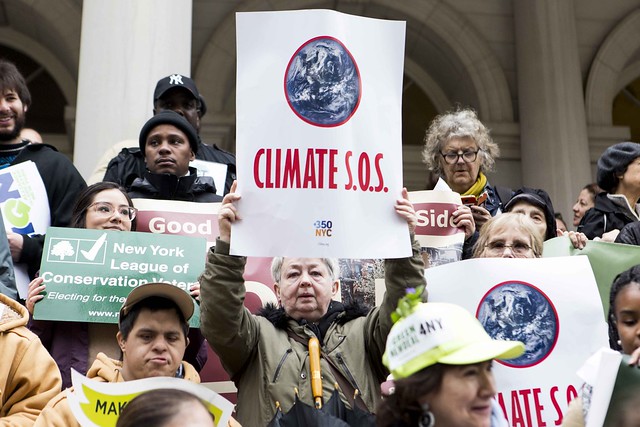
(photo: Emil Cohen/City Council)
Grassroots climate activists hope that before state lawmakers adjourn for the summer they will strike a deal with Governor Cuomo to adopt the strongest climate legislation possible.
And let’s be clear: the strongest climate bill is the NYS OFF Act (A3565/S5526), not the more publicized Climate and Community Protection Act (CCPA).
The Off Fossil Fuels Act, for 100% renewable energy by 2030, grew out of the successful grassroots campaign to ban fracking in New York. It seeks to implement the study done by Stanford and Cornell professors showing how the state could by 2030 obtain 100% of its energy from solar, wind, geothermal, and conservation. It includes the critical component of calling for a halt to all new fossil projects, a measure not included in either the CCPA or by the governor in his agenda. Forty state lawmakers are sponsoring the OFF Act.
The CCPA deserves praise for making environmental justice and a “just transition” central objectives of any climate action. But its climate policies are centered around enacting into law a ten-year-old Executive Order from the Paterson administration. The bill that the State Assembly passed every year since 2009 to do that was changed three years ago to the CCPA, adding environmental justice and labor provisions.
Our understanding of climate change has itself changed a lot in the last decade, especially so in the last three years. The climate goals in the CCPA were rejected by developing countries at the Paris climate talks. They rebelled against the industrial polluter nations which want a goal of keeping global warming below 2 degrees Celsius, insisting the target be lowered to 1.5 degrees.
The International Panel on Climate Change (IPCC) recently warned the world that it had to significantly step up its climate actions as we have less than 12 years left to save life on the planet. The IPCC is a conservative body, due to the nature of “scientific consensus” and because its pronouncements need to be approved by the fossil-fuel centered countries like Saudi Arabia, the United States, Russia, and Brazil. Every study by the IPPC has understated the speed and severity of climate change. As one of its authors has said, for an accurate read, take our worst case scenario and double it.
Even Governor Cuomo upgraded his climate goals following the IPCC report, now calling for 70% of state electricity to be renewable by 2030.
I spent more than three decades organizing for a variety of low-income community groups to end poverty and promote economic justice. We cannot solve the climate crisis without ensuring that the poor and workers benefit from the transition. While dedicating jobs and climate funding to lift up disadvantaged communities, we need to advocate for policies that ensure such communities are not blown, washed, or burnt away by extreme weather.
We need to remember that it is the developing world that is home to the principal victims of climate change. Half of the residents of Puerto Rico were without electricity and drinking water for six months – and they are part of the United States (despite how the Trump administration may approach them)!
Scientists now openly discuss the possibility of human extinction and/or the end of civilization as we know it. The Extinction Rebellion has risen to demand an end to greenhouse gas emissions by 2025. A majority of Congressional Democrats from New York sponsor the federal Green New Deal with its 2030 timeline and the federal OFF Act with a goal of 2035. How can New York pursue a timeline decades slower?
We have to enact bold, even radical, climate measures that increase the chances of humans surviving climate chaos. We have to reject the approach of embracing incremental measures that politicians, paid for by fossil fuel campaign contributions, find “reasonable.”
New York lawmakers need to take the best ideas from the OFF Act, CCPA, Cuomo’s agenda, and the half-dozen other climate bills. Climate activists need to weigh in on the details of the dozens of issues being negotiated by legislative leaders.
The just transition provisions of the OFF Act are stronger than the CCPA in guaranteeing jobs and wages for displaced workers and assisting communities dependent on tax payments from existing fossil fuel plants. The climate funding for disadvantaged communities in the CCPA is more limited than what its supporters believe. A key fight will be over how much funding is allocated and for what type of projects.
We need to develop detailed climate plans with short-term benchmarks with no more than two-year intervals for review and update. New York is not even close to achieving its goals for renewable energy established by the Pataki administration in 2002. Lawmakers need to allocate probably $10 billion a year to support the transition, an issue that has been largely ignored.
Local governments must also develop climate action plans, especially to site large-scale renewable energy projects, which at present are largely impossible to approve.
Many of the enforcement provisions in the CCPA were weakened by the Assembly. Those provisions should be restored, such as state agency compliance and the right for citizens to sue to enforce the law.
Far more action is needed on transportation and buildings, with each accounting for more than a third of the state carbon footprint.
New York cannot afford to waste this opportunity to adopt the best climate agenda. The devil is in the details. We need to listen to our children who want a world that gives them a chance for a decent future.
***
Mark Dunlea is Chair of the Green Education and Legal Fund. On Twitter @DunleaMark.
***
Have an op-ed idea or submission for Gotham Gazette? Email This email address is being protected from spambots. You need JavaScript enabled to view it.
'Blow Up the MTA'? Not Yet
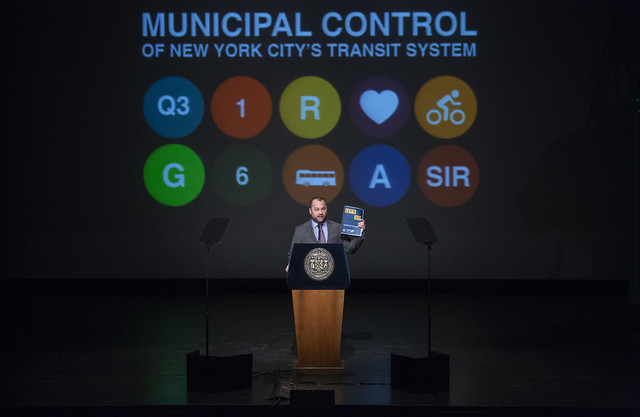
Council Speaker Corey Johnson (photo: John McCarten/City Council)
With subway and bus riders so frustrated with poor service, it is understandable that city leaders are talking about changing the governance of the MTA and its New York City Transit (NYCT) division as a solution.
Most notably, City Council Speaker Corey Johnson has come up with a well-intentioned but ultimately misguided plan to break NYCT off from the MTA and vest full responsibility for its funding and operation in a mayor-controlled structure he’s named Big Apple Transit, or BAT. BAT would run the city transit used by millions of New Yorkers every day.
The speaker and I, along with MTA Board member Veronica Vanterpool and moderator Charles Komanoff, appeared Wednesday evening on a panel to discuss his plan, part of the Theodore Kheel Fellowship Program at Roosevelt House at Hunter College.
The appeal of the speaker’s plan has been enhanced by Governor Cuomo’s pre-election (and continuing, although to a lesser extent) protestations that neither he nor anyone, really, controls the MTA and is responsible for improving how it operates.
But shifting from MTA to city government control would only substitute New York City-centric political challenges for regional ones, and could well make some of the system’s problems worse. Attention and effort would more usefully be focused on reminding the current MTA Board of its fiduciary responsibility to the agency, not to the Governor, demanding more transparency and requiring serious oversight by the State Legislature.
It is far easier to argue for city control of subways and buses than to get into the weeds of how to reform MTA procurement, why and how to install a new signal system, or the need for work rule changes in union contracts. But these are the dynamics that need change the most.
There are several reasons why a shift in control of subways and buses from a regional to a city authority would be problematic.
First, the separation of city buses and subways from the rest of the MTA’s assets runs counter to the long-term goal of creating a more integrated regional transit system. More than 1.1 million people commute into New York City to work. They swipe their metrocards half-a-million times a day. We need these workers to contribute to the city’s economy, shop, and pay sales taxes in addition to bridge tolls and fares that help support the buses and subways. We need to be thinking about how to better connect Westchester and Long Island transit systems (and yes, New Jersey and Connecticut as well) to the city’s, not allow them to exist in siloes.
Second, even if it were desirable, a new Big Apple Transit would not be financially viable. We have a Metropolitan Transit Authority because it serves, and derives revenue from, seven suburban counties in addition to the five boroughs of New York City.
The Payroll Mobility Tax and the dedicated regional sales tax are levied on businesses and activities in the region with suburban counties as well as residents and businesses paying a significant share. In particular, the PMT generates more than $1 billion per year for NYCT. This tax was vehemently opposed by suburban legislators when it was adopted in 2009 and it has repeatedly been subjected to various exceptions. The state Legislature agreed to make up some of the lost revenue from the exemptions.
Can there be any doubt that if NYCT were separated from the regional MTA the state Legislature would quickly and gleefully cease providing the lost revenue from the exemption from the PMT and might well suspend or redirect other regional taxes designated for the MTA exclusively to the LIRR and Metro North?
This could mean that city residents and businesses would be required to make up the loss of some of the $2 billion in annual revenue from sales taxes, ride-hail surcharges, mortgage transfer fees, etc. now devoted to the NYCT. Even if replacement of these revenues with local taxes were acceptable to the public(!), there is no guarantee that the state Legislature would grant New Yor City authority to impose them.
And the subsidy from general state revenue would be at risk as well. The governor has made his view on this clear: “If New York City took [transit] over, they take it over. They don’t get the state funding.”
Speaker Johnson’s proposal assumes that all regional and state subsidies to NYCT would remain in place and even then, he projects the city would need to come up with an additional $1-1.5 billion in revenue a year. The loss of any or all state and regional support, totaling almost $3 billion a year, could make the shortfall overwhelming and would require significant increases in fares and other taxes. And the shortfall would be even worse if there is a recession.Will city taxpayers and riders put up with absorbing all of that?
It is of course undeniable that the MTA Board structure obscures accountability. But it is necessary and appropriate for a regional transit system to have representation of all the impacted counties on its board.
Nonetheless, the Mayor has more appointees than anyone besides the Governor, who also appoints the CEO/Chair. After all the drama of the last year over service disruptions, the declaration of a state of emergency to expedite repair work, the announcement of the Fast Forward Plan, and the governor’s last-minute intervention and rejection of the planned shutdown of the L line for a modified plan, it is now abundantly clear that the buck stops with the Governor.
Yes, the Board needs to fulfill its fiduciary responsibilities, be more transparent and exercise better oversight, but merely switching ultimate responsibility from one elected official to another will not change the fact that, so long as public transit is a public responsibility, it will have political leadership that shies away from making tough decisions.
To properly maintain and improve 24-hour bus and subway service, fares need to be regularly and steadily raised. Service needs to be suspended on some lines for periods of time so they can be properly maintained and repaired. A Board appointed by the Mayor will not find these decisions any easier than one controlled by the Governor, especially if it has to generate even more revenue because of the absence of state and regional tax support.
It is clear that one of the main drivers of NYCT cost growth is personnel. Why will the Mayor be any more likely than the Governor to resist the power of the Transportation Workers Union (TWU) and other labor unions? Notwithstanding Governor Cuomo’s intervention in 2014 to forge a contract settlement with transit unions – with no productivity initiatives or fringe benefit savings to offset wage increases – TWU head John Samuelson is already threatening a strike in response to recent exposés on overtime abuses and related criticism. A Mayor would be even more susceptible to these kinds of threats.
Disjointed regional transit planning and administration, possible loss of substantial state and regional funding, a fraught environment in which to implement fare increases, raise taxes, and negotiate labor contracts – these are the likely results of “blowing up the MTA.” Better to focus on practical, feasible steps to make the MTA work better right now. Reinvent Albany recently published a report with 50 Actions New York Can Take To Renew Public Trust in the Metropolitan Transportation Authority that contains many worthwhile proposals. Among the most significant:
-The MTA Board should vote on policy decisions, not adopt them de facto though contract approvals.
-The Senate and Assembly should create committees dedicated specifically to oversight of the MTA, not treat it as part of the general Transportation or Authorities Committee jurisdiction where the MTA region are not well-enough represented.
-MTA Board members should be subject to a real, thorough vetting and confirmation process.
-There should be much more open data on contracts, project progress, budget and capital planning.
-The MTA fiscal year should be moved to begin in July instead of January, so state budget actions can be taken into account in financial planning.
-Procurement should be streamlined so there are fewer incentives for change orders and cost overruns.
Instead of devoting time and attention to the idea of putting different people in the seats on the deck of the Titanic, let’s work on getting the ship into stable waters and smooth sailing by insisting on competence and accountability from the crew we have.
***
Carol Kellermann was president of Citizens Budget Commission from 2008 through 2018.
***
Have an op-ed idea or submission for Gotham Gazette? Email This email address is being protected from spambots. You need JavaScript enabled to view it.
***
Have an op-ed idea or submission for Gotham Gazette? Email This email address is being protected from spambots. You need JavaScript enabled to view it.
We Can Help Thousands More Residents of Affordable Housing Register to Vote

(photo: Michael Appleton/Mayoral Photography Office)
No one’s socioeconomic status should limit their capacity to make their voice heard at the ballot box. But more must be done to ensure that low-income populations across the nation are registered to vote and can participate in the democratic process.
We can help address this issue in New York by taking more information directly to residents in and around their own apartment buildings. Managers of affordable housing developments can play a significant role in connecting tenants with the information needed to register to vote.
That is why NYSAFAH is launching a non-partisan voter registration initiative that will target residents of affordable housing developments that are managed by our members. Through this effort, we can help thousands more low-income New Yorkers register to vote by the end of this year.
NYSAFAH is the state’s trade association of affordable housing developers, managers, architects, planners, and others who help build and preserve homes for low- and middle-income New Yorkers.
Our first priority is to deliver quality housing for New Yorkers. However, being good stewards of affordable housing often extends beyond the day-to-day maintenance of four walls and a roof.
Our members also impact the lives of their residents by helping them access social services, participate in recreational programming and engage in other activities that contribute to strong families and healthy living. We believe that working to increase rates of voter registration can become an important part of that broader mission.
As part of our new initiative, NYSAFAH will partner with the New York City League of Women Voters to advance a coordinated outreach campaign that is driven by direct engagement with residents. This outreach will include voter registration drives held at buildings in which residents live. At these sessions, managers will provide non-partisan guidance and information with the goal of maximizing voter registration among the resident population.
NYSAFAH members collectively manage hundreds of buildings across the five boroughs, with tens of thousands of residents overall. This makes for an even greater opportunity to have a real impact on boosting rates of voter registration among low-income communities throughout New York.
As we make progress on this front, we will also be taking an important first step toward advancing the broader goal of increasing voter participation – when more of us vote, we all benefit from a stronger democracy.
And after all, this just makes sense. When it comes to engaging with residents, why not start with a renewed effort to give them more of the tools they need right at home?
We have already received a great deal of positive feedback from NYSAFAH members who are excited to embark on what we all believe will be a crucial initiative for our state. Our team looks forward to seeing thousands more New Yorkers registered to vote – and we hope that this work can serve as a model for future initiatives to keep advancing the ball.
***
Jolie Milstein is president and CEO of the New York State Association for Affordable Housing (NYSAFAH). On Twitter @NYSAFAH.
***
Have an op-ed idea or submission for Gotham Gazette? Email This email address is being protected from spambots. You need JavaScript enabled to view it.
T-Mobile-Sprint Merger Will Help Those Who’ve Been Left Behind in the Digital Age
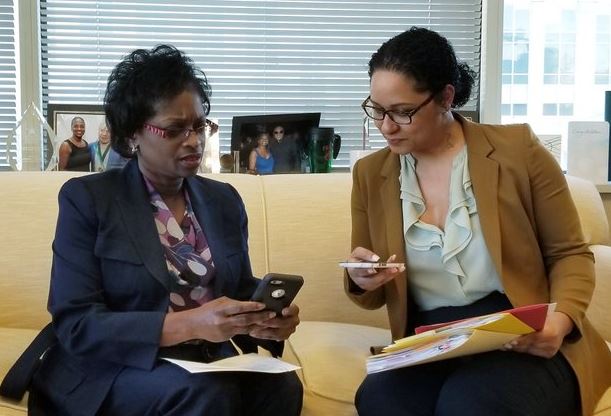
Mignon Clyburn, the author, left (photo: @MignonClyburn)
Wireless broadband should reach communities of color at the same time it reaches most of the U.S. population.
Why do I say this…or is the question really, why am I still saying this in 2019?
While serving nine years as a Federal Communications Commissioner, I saw firsthand how wireless broadband access expands access to jobs, enriches education, and deepens political engagement. Losing out on wireless broadband opportunities today increases the risk of us losing out on just about everything the future holds.
In a recent roundtable discussion at New York Law School about “5G,” the next generation of wireless technology, I spoke about how both government and industry need to keenly focus on ensuring that underserved communities receive the anticipated benefits of 5G sooner rather than later. And, in my view, approving the T-Mobile/Sprint merger is one of the best ways to ensure inclusive broadband deployments.
T-Mobile, which I am currently advising, has long been an ally of underserved consumers. You find their stores in markets other providers avoid, and the company has doubled down and broadened access to key communications and technological services.
Consider T-Mobile's investments in MetroPCS, the prepaid brand it acquired in 2013, and you will find an unwavering commitment to cost-conscious communities. And that's not all—T-Mobile has helped hundreds of thousands of Americans, including thousands of New Yorkers, build a credit history by enabling, and in many cases encouraging, a transition from prepaid to postpaid phone plans. T-Mobile has bridged the gap between Metro and postpaid phone plans, allowing Metro customers to have a comparable experience to those on postpaid plans.
The merger with Sprint will enable a massive new investment by T-Mobile—nearly $40 billion, to be exact—to create an inclusive, nationwide 5G network and services that will greatly improve access to broadband for all New Yorkers, not just the wealthy.
In my time at the FCC, I worked on expanding wireless service in underserved neighborhoods because I recognized early on that broadband connectivity offers an ever-present stepping stone for upward mobility. Now in 2011, I opposed the proposed AT&T/T-Mobile merger, in part because AT&T already controlled 44 percent of the market. But unlike that deal, the T-Mobile/Sprint merger will combine the two smallest nationwide providers and strengthen a maverick that can better compete against two dominant players.
From Bed-Stuy to Buffalo, the combined company’s expansive deployment plan promises to bring us closer to bridging the digital divide, and it will do so in an affordable way.
The companies have pledged to offer the same services T-Mobile and Sprint currently offer at the same prices for three years or until better plans that offer lower prices or more data are made available. This means that competition will quickly heat up and prices will likely come down as other carriers feel the heat.
No one stands to benefit more from this fierce competition than those currently underserved. Research, including the work of Brookings Institution expert Nicol Turner Lee, shows that lower-income Americans are the most likely to rely on wireless as their primary or sole means of connecting to the internet. The 5G network enabled by the T-Mobile/Sprint merger will allow customers who can’t afford expensive in-home broadband to access broadband-equivalent speeds on their phones.
While at the FCC, I was proud to have strengthened the Lifeline program, which subsidizes wireless service for those who otherwise could not afford it. T-Mobile and Sprint have not only committed to continue supporting this important service in New York and across the country, but they will also maintain support for programs like Sprint's 1Million Project, which provides service and devices to worthy high school students.
The New York Public Service Commission has already approved the merger of T-Mobile and Sprint, and I hope that those who are still reviewing the transaction at the federal and state levels will not stand in the way.
The status quo is not acceptable. What is needed is for a proven wireless industry disruptor to expand on a larger scale, bringing wider and better connectivity opportunities to New Yorkers as we move into the 5G era. For those currently on the wrong side of the digital divide, change cannot come soon enough.
***
Mignon Clyburn served as Federal Communications Commission Commissioner from 2009 to 2018, and is currently an adviser to T-Mobile. On Twitter @MignonClyburn.
***
Have an op-ed idea or submission for Gotham Gazette? Email This email address is being protected from spambots. You need JavaScript enabled to view it.
Social Workers for Homeless Kids is Not the Place to Skimp
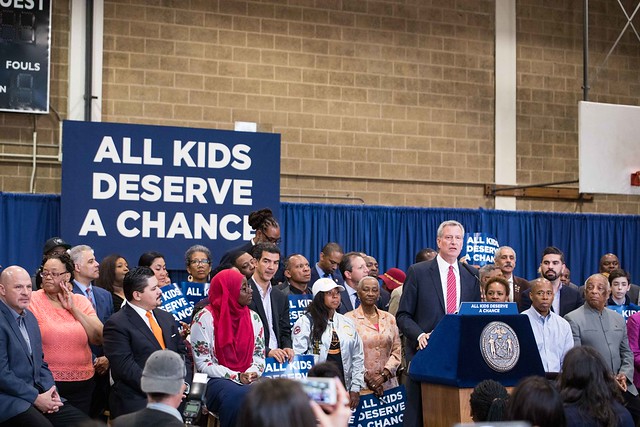
(photo: Benjamin Kanter/Mayoral Photo Office)
Last year, nearly 38,000 New York City students arrived in the classroom having woken up in a shelter. That’s more students than the total enrollment of the Buffalo public schools, the next largest school district in the state.
Many had been exposed to domestic violence, one of the driving forces of homelessness. Many were forced to transfer schools mid-year, some multiple times, after being placed in a shelter in an entirely different borough. Some were in placements with no kitchen or laundry machine. More than half missed the equivalent of an entire month of the school year due to absences.
Imagine being dropped abruptly mid-year into a classroom where you know no one and have to get used to a new school—all while wondering how long your family will have to stay in a shelter. Imagine having 50 students in this situation—two full kindergarten classrooms of children—come into your school every day, and not having any additional staff to focus on supporting them.
For many students and schools, this is reality.
As the number of children experiencing homelessness has skyrocketed, it is essential that schools serving large numbers of students living in shelter have trained professionals dedicated to meeting their needs.
Three years ago, Mayor de Blasio launched a program to place 33 “Bridging the Gap” social workers in schools with high concentrations of students living in shelter. This year, with additional funding from the mayor and the City Council, there are 69 Bridging the Gap social workers. These social workers provide much-needed counseling to address the trauma that can interfere with the school performance of students living in shelters and work to address barriers to regular school attendance.
However, far too many schools still lack this critical support. In fact, 100 schools have 50 or more students living in shelter and no Bridging the Gap social worker.
We were baffled that, for the third year, instead of increasing funding for Bridging the Gap social workers, Mayor de Blasio omitted all funding for this program from his preliminary budget, jeopardizing its continuation.
Following an outcry from Council members and advocates, the mayor restored funding for 53 of the 69 social workers in his executive budget last month. While we were pleased that the mayor included long-term (“baselined”) funding for the 53 social workers, ending the annual budget dance, we were disheartened that 16 social workers remained at risk, especially when we need even more than 69.
Following further criticism, the administration announced that it would restore funding for the remaining 16 social workers just before the City Council began its executive budget hearings last week.
The administration has cited the restoration of the Bridging the Gap social workers as a key way that it has been responsive to the Council’s priorities. But the Council has asked for an increase—not merely a restoration—of the program.
In fact, 35 Council members, as well as shelter providers and education advocates, have called on the mayor to add $5 million to the budget to increase the number of Bridging the Gap social workers from 69 to at least 100.
Cutting funding for the program and then restoring it should not be viewed as a victory when thousands of students living in shelter lack access to the crucial help Bridging the Gap social workers can provide.
Schools alone cannot end homelessness. But, with the right support, schools can transform the lives of students who are homeless. As Mayor de Blasio has stated, a quality education is “the most powerful tool we know for lifting one’s life chances.”
To break the cycle of homelessness, the city must devote more attention and resources to the education of students living in shelter. The mayor should start by providing funding for at least 100 school social workers for students living in shelter in this year’s budget.
***
Kim Sweet is Executive Director of Advocates for Children of New York. On Twitter @AFCNewYork.
***
Have an op-ed idea or submission for Gotham Gazette? Email This email address is being protected from spambots. You need JavaScript enabled to view it.
Care about Climate Change? Care About Scooters

(photo: Lime)
Solving our biggest global crisis of a rapidly warming planet means considering everything through the lens of potential solutions, even something as small as the electric scooter.
Micromobility is rightfully capturing the keen attention of urbanists around the world -- including the much-discussed e-scooter. And New York is poised to take advantage as well.
Simultaneously, New York is considering various necessarily ambitious policies to combat climate change and legislation to authorize local governments to roll out micromobility programs. Statewide, transportation is the number one source of carbon emissions, so these revolutions are closely related.
But New York must act decisively -- and quickly -- on both issues if it is going to start reducing its carbon footprint at a rate that allows it to reach its global warming goals and to prevent the harmful health effects of local pollution.
A recent International Panel on Climate Change (IPCC) report concluded we have 12 years to prevent the worst of climate impacts. Subsequent reports find our climate pollution emissions have continued to accelerate. Arctic melting has, as well. New York has already felt the dramatic and tragic effects of climate change, enduring the terrible power of Hurricane Sandy.
So any chance to significantly reduce the effects of climate change must be taken, especially when it improves other aspects of daily life. That’s where micromobility offers a tremendous opportunity.
Take the electric scooter itself, an under 50-pound mode of transit. Scooters stand in stark contrast to one- and two-ton cars, and the energy it takes to move them and space consumed to park them. Right now, two-thirds of trips made by car are under one mile. That’s a massive waste of energy when a large number of those trips are just one able-bodied person who could easily -- and often more quickly -- use a carbon-neutral option like a scooter.
People have noticed this when they have access to scooters, and the change trend is already well underway. They have taken shared scooters on over 50 million rides in the last year alone.
Moreover, independent studies by city transportation departments and internal company research have both found a roughly one-third, or often more, mode-shift in cities from scooters. This means one out of every three scooter rides is a trip not taken by ride-hailing, taxi, or personal vehicle, and when most vehicles are still one to two ton gas burning cars, that's a big deal for climate pollution.
It is also a big deal for public health, as local pollution afflicts people with health complications like asthma, and more often the urban young and old and people of color, a threat equal to a history of smoking.
For the New York City metro area, 100,000 shared scooters and bikes could easily prevent more than 300,000 car trips each day. That would also prevent nearly 50,000 tons of carbon annually and 4 tons of asthma-inducing particulates.
Right now, we need government leaders at all levels to have an Apollo-like mindset to the climate crisis and, as a result, measure every major policy decision through the lens of the climate fight. Scooters and electric micromobility are just one of the myriad of solutions we will need to deploy now to have a chance of making an impact on this global challenge.
We’ve done this before. During World War II, every major policy decision was put through the filter of the war effort. That allowed us to turn our economy into a giant cog of mission-oriented productivity, going, for example, from a production of just 3,000 bombers to a staggering 300,000 in those few years.
It’s time to make bold changes in the effort against this climate crisis. If this is our modern World War III, we'd better get moving, big and small, on city streets across the globe. New York can do its part by authorizing micromobility statewide right now.
***
Andrew Savage is vice president of sustainability and a founding team member of Lime, a mobility company that makes scooters, bikes, and more. He is a veteran of local, state, and federal government. On Twitter @limebike.
***
Have an op-ed idea or submission for Gotham Gazette? Email This email address is being protected from spambots. You need JavaScript enabled to view it.
No Money or False Information Can Change the Fact that Banning Fur and Foie Gras is the Right Thing To Do

(photo: Pixabay License)
Industries that exploit and abuse animals have a lot of money and a lot to hide. Whether it be the fur industry, which abuses and kills animals for their skins, or the foie gras industry, which rams a foot-long pipe down the throats of innocent ducks for a luxury food item, resorting to Trump-like tactics of lies, fear-mongering, and bullying is a telltale sign that you’re on the wrong side of history.
In New York City, we have two of the most abusive and morally bankrupt industries on earth -- fur and foie gras -- spending hundreds of thousands of dollars to spread misinformation and bully City Council members to get them to oppose two common-sense animal protection bills that seek to end the cruelties in their unregulated industries.
A perfect example is the fur industry’s recent blanketing of Speaker Corey Johnson’s district with ridiculous mailers filled with false information. Speaker Johnson should be applauded, not attacked, for working to protect animals.
Another bill, Intro. 1378, would prohibit the sale of force-fed foie gras in New York City. Foie Gras is a luxury food product sold in about 1.5% of New York City restaurants. It is produced by violently shoving a metal or plastic foot-long pipe down a bird's throat, then pumping him with so much feed that, after three times a day for several weeks, his liver becomes grossly diseased and enlarged to ten times its normal size.
The bill is supported by 81% of New Yorkers, according to a Mason Dixon poll, and over 50 New York-based veterinarians, 100 restaurants, and over 60 not-for-profit organizations have endorsed it. The only opposition to this bill is the industry that profits from the abuse. A new poll just release by Fur Free NYC shows a staggering 75% of New York City voters support a ban on the sale of fur.
On fur, Intro. 1476 would prohibit the sale of fur apparel in New York City. Worldwide, over 100 million animals are abused and killed for their fur every year. Whether raised on fur farms in tiny wire cages or trapped from the wild with cruel leg-hold traps, fur-bearing animals -- including foxes, coyotes, wolves, otters, dogs, cats, and raccoon dogs -- have unimaginable cruelty inflicted upon them.
Designers, retailers, and cities around the world are joining together in banning the sale of fur and shutting down fur farms due to the cruelties involved. In the past 18 months, Chanel, Phillip Lim, Jean Paul Gaultier, Coach, Burberry, Gucci, Michael Kors, and more have all banned fur. Here in the United States, the cities of Los Angeles and San Francisco have recently banned the sale and manufacturing of fur, while cities and countries across Europe and Asia are seeking to do the same.
These industries cannot win a civil debate on the merits, so they resort to using their money to bully and spread misinformation to the general public and the City Council—representing everything that is wrong in politics. They’ve hired expensive lobbyists and marketing firms to spin the truth, sent out thousands of mailers and robocalls with misinformation, and bought ads that are riddled with lies to cause fear among New Yorkers. These tactics are from a Trump-like playbook and have no place in this great city.
On the other hand, non-profit groups that advocate for animal rights refuse to entertain these abusive industries’ morally dubious political theater. As Michelle Obama famously said, “when they go low, we go high.” That is exactly what we will do on behalf of animals.
Our coalition of more than 50 organizations will rely on facts, evidence, and science to support the policies we promote. We welcome transparency, debate, and fairness in the legislative process. We operate in the open and don’t try to influence in the shadows. At Voters for Animal Rights, we’re an all-volunteer organization that works to protect animals on an annual budget that is roughly the same as a lobbyist’s monthly retainer to represent the fur industry.
We fight for animals for one simple reason: it’s the right thing to do. They oppose animal protection laws because it threatens their bank accounts.
We are at a pivotal juncture in our society: we can either take back our democracy from powerful, unethical industries or allow those with money to undermine and destroy what makes New York a beacon of light for good. We humbly call on New Yorkers to denounce “alternative facts,” and tell the abusive fur and foie gras industries “No.”
We will not be bullied. We will not stop fighting for the rights of animals. We will not remain silent as they torture innocent animals for profit.
It’s clear that fur and foie gras are products of extreme cruelty and should be relegated to the waste bins of history. Together, we can make New York City a better city by rejecting the fur and foie gras industries’ Trumpian political tactics and pass Intros. 1378 and 1476 without delay.
***
Matthew Dominguez and Allie Feldman Taylor are leaders of Voters For Animal Rights. On Twitter @theanimalvoters.
***
Have an op-ed idea or submission for Gotham Gazette? Email This email address is being protected from spambots. You need JavaScript enabled to view it.
‘Free College’ at One SUNY School Shows ‘Excelsior’ Progress and Problems
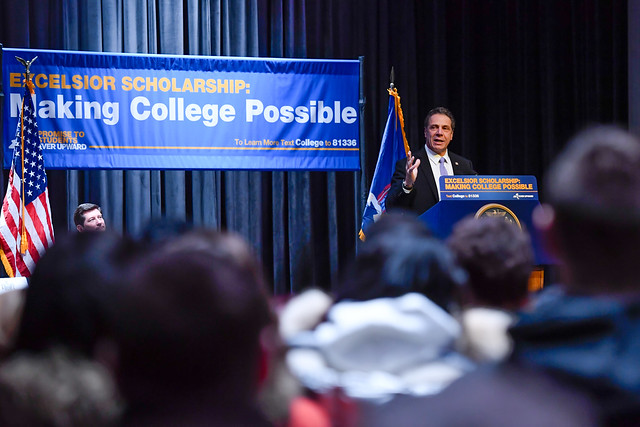
(photo: governor's office)
Governor Andrew Cuomo’s Excelsior Scholarship is increasing credit accumulation and college retention rates, but the program still needs to meet more students where they are at.
In 2017, Governor Cuomo embraced the “free college” movement championed by Senator Bernie Sanders and created New York State’s Excelsior Scholarship. Under Excelsior, students from families with annual incomes below $110,000—and increasing to $125,000 in fall 2019—can go to State University of New York (SUNY) and the City University of New York (CUNY) schools tuition-free.
Excelsior is a “last dollar” scholarship program that pays tuition amounts for full-time students that are not already covered by the federal Pell program and New York State’s nearly $1 billion Tuition Assistance Program. This is one factor that has kept the scholarship’s scale relatively small, covering just 3.2% of SUNY and CUNY students, according to a Center for an Urban Future report on Excelsior’s first year.
In fall 2017, approximately 400 of the 26,000 students at SUNY Suffolk County Community College on Long Island (SCCC) received Excelsior, according to SCCC data that was provided in response to a Freedom of Information Act request. Excelsior awards funds of up to the full cost of tuition, which at SCCC was $2,385 per semester in 2017-2018, or $4,770 per year.
Of SCCC’s 400 or so Excelsior recipients, 300 were first-year freshman students, and 161 of those students, or 53.7%, earned 30 or more credits during their freshman years. Having 30 or more credits at the end of freshman year is a requirement for maintaining Excelsior and is a milestone on the way to graduating in two-years.
SCCC does not report the rate at which its general population of students earn 30 or more credits in their freshman year, yet other public institutions do. For instance, at CUNY, 10.7% of associate degree full-time freshman students earn 30 or more credits as freshmen.
The rate at which the SCCC general population earns 30 or more credits may exceed the CUNY rate by several percentage points, but not by a multiple of two or more given that SCCC's two-year graduation rate of is very similar to the two-year graduation rate for CUNY associate degree students of 7.7%.
Within this context, the 53.7% rate at which SCCC Excelsior recipients earned 30 or more credits extraordinary.
The Excelsior regulations strongly incentivize students toward meeting the 30-credit milestone.
First, students who earn the 30 or more credits annually get to maintain the scholarship. Second, those who fail to meet the threshold must pay back one semester of their Excelsior awards. This means that bills of up to $2,385 faced SCCC Excelsior freshmen who did not meet the 30-credit threshold and did not present a special circumstance warranting an exception, like a parent’s death, or have earned credits from high school dual enrollment programs to help lift them over the 30 credit benchmark.
The punitive nature of the regulations, which many see as unfair, is a unique feature of New York State’s “free college” program, and it may play a significant a role in incentivizing students to accumulate credits at rates faster than they would otherwise.
The credit accumulation results were impressive, but what were Excelsior’s effects on retention?
As one would imagine, the retention outcomes are different for students who earned 30 or more credits from those who did not. Of the 161 students who earned 30 or more credits, 91.3%—or almost all—continued at SCCC as sophomores.
Of the 139 students who fell short of the 30 credits, 64.7% re-enrolled for their sophomore years. These students, unless they were successful in appealing to the Higher Education Services Corporation (HESC) for continued Excelsior eligibility or had banked dual enrollment credits, started paying tuition and had to pay back one semester of their Excelsior awards, which together could total nearly $5,000.
Overall, of the 300 Excelsior freshmen, 237 of them, comprising 79.0% of the group, returned to SCCC for their sophomore years. This is about ten percentage points higher than the 69% rate at which first-time, full-time SCCC freshmen returned for their sophomore years during a recent pre-Excelsior year at SCCC.
Data on Excelsior is Limited
The retention data from SCCC is consistent with overall SUNY and CUNY data. In January, SUNY officials reported a retention rate for SUNY’s Excelsior Scholarship students of 75.7%, compared to 67.9% for SUNY non-Excelsior students. Also in January, CUNY reported a retention rate of 79% for Excelsior students, as compared to 67.4% for non-Excelsior recipients.
Detailed data from across the state on Excelsior students’ credit accumulation rates and the interplays between credit accumulation, retention, the size of students’ Excelsior awards, and other variables, like race and ethnicity, has not been made available by HESC, which administers Excelsior.
In late January, Acting HESC President Dr. Guillermo Linares testified before a joint legislative hearing in Albany but ducked questions asking for the rates at which Excelsior students have been meeting the 30-credit benchmark. When Assemblymember Deborah Glick asked about students who have “fallen off of receiving Excelsior,” Linares said quixotically, “We’re not aware of any that have not received.”
Senator Toby Ann Stavisky asked directly whether “students [have] failed to fill the 30-credit,” and Linares said only, “There are very positive signs.” When Stavisky followed-up and specifically requested the “percentage that have failed to complete the 30-credit requirement,” Linares stammered back, “It’s very promising.”
HESC has replied to FOIA requests that I have made by saying that they need more time to respond. The sooner they can, the better. More data would help inform a policy debate on how Excelsior can be improved for the future and how “free college” programs should be designed in other states.
Drew Biondo, SCCC’s Director of Communications, said in a brief statement that Excelsior's full "benefit to our students, while showing early successes, will not be known for several more years."
Two Excelsior Policies that Need to Be Changed
As the conversation about Excelsior continues, serious consideration should be given to lowering the annual credit accumulation requirement to 27 credits.
If the standard was 27 credits rather than 30 credits, a significant number of additional SCCC Excelsior freshman would have earned enough credits to have met Excelsior’s benchmark.
As it stands now, Governor Cuomo’s touting of Excelsior’s success is like an algebra teacher congratulating him/herself on 53.7% of his students passing an exam; there’s nothing in such as a case to warrant self-congratulations.
A second change that should be considered is the provision of funds to support free summer enrollments. At SCCC, 62 of the 161 students (38.5%) who met the 30-credit threshold took at least one summer class that was paid for out of their own pockets. This is a significant percentage of students enrolling in summer classes. Consideration should be given to modifying Excelsior so that students who earn 24 or more credits during the regular academic year receive additional funds to take a summer class for free.
Excelsior’s scale is currently limited, costing the state $92 million during the last fiscal year, compared to the nearly $1 billion size of the TAP program. As a program that is still small (even if Cuomo’s rhetoric is anything but), now is the time consider improvements before Excelsior’s design choices become too entrenched.
In considering policy changes, their implications for how Excelsior funds are divided between SUNY and CUNY students and institutions should be evaluated.
At present, SUNY students and institutions benefit from Excelsior funds to a much greater degree than do CUNY students and institutions. According to an August 2018 report from the New York City-based Center for an Urban Future (CUF) based on HESC data, 20.7% of Excelsior’s 2017-2018 recipients attended CUNY institutions despite CUNY students comprising 38% of the state’s undergraduate population. CUF attributes the imbalance to Excelsior’s heavy credit requirements, which are more often met by SUNY students than by CUNY students.
More research would help determine whether making the above changes to Excelsior would rebalance the distribution of awards between CUNY and SUNY or exacerbate the imbalance.
***
Methodological note: SCCC provided raw data in response to the Freedom of Information Act request but did not provide comprehensive student record data. This research could be extended further with more data and verification of data elements from SCCC.
***
Eric Neutuch is a freelance journalist.
***
Have an op-ed idea or submission for Gotham Gazette? Email This email address is being protected from spambots. You need JavaScript enabled to view it.




